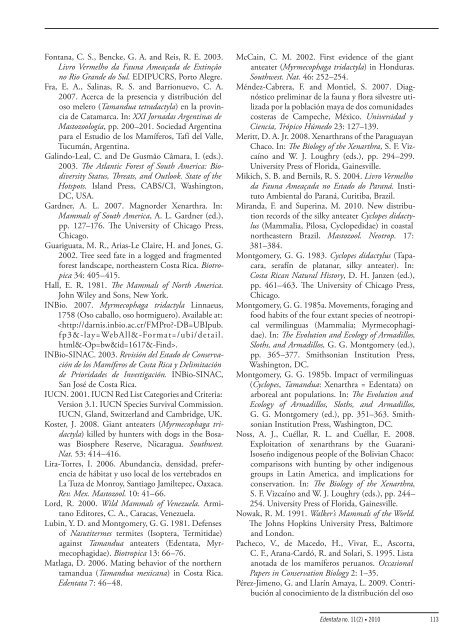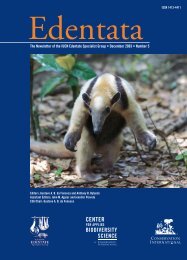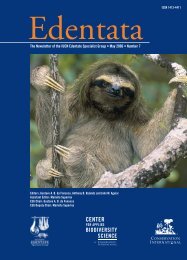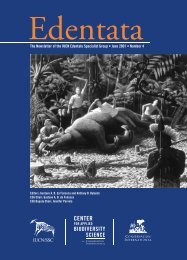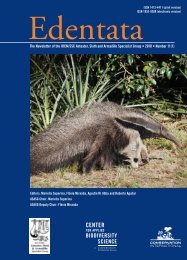Edentata 11(2), 2010 - Anteater, Sloth & Armadillo Specialist Group
Edentata 11(2), 2010 - Anteater, Sloth & Armadillo Specialist Group
Edentata 11(2), 2010 - Anteater, Sloth & Armadillo Specialist Group
- No tags were found...
You also want an ePaper? Increase the reach of your titles
YUMPU automatically turns print PDFs into web optimized ePapers that Google loves.
Fontana, C. S., Bencke, G. A. and Reis, R. E. 2003.Livro Vermelho da Fauna Ameaçada de Extinçãono Rio Grande do Sul. EDIPUCRS, Porto Alegre.Fra, E. A., Salinas, R. S. and Barrionuevo, C. A.2007. Acerca de la presencia y distribución deloso melero (Tamandua tetradactyla) en la provinciade Catamarca. In: XXI Jornadas Argentinas deMastozoología, pp. 200–201. Sociedad Argentinapara el Estudio de los Mamíferos, Tafí del Valle,Tucumán, Argentina.Galindo-Leal, C. and De Gusmão Câmara, I. (eds.).2003. The Atlantic Forest of South America: BiodiversityStatus, Threats, and Outlook. State of theHotspots. Island Press, CABS/CI, Washington,DC, USA.Gardner, A. L. 2007. Magnorder Xenarthra. In:Mammals of South America, A. L. Gardner (ed.),pp. 127–176. The University of Chicago Press,Chicago.Guariguata, M. R., Arias-Le Claire, H. and Jones, G.2002. Tree seed fate in a logged and fragmentedforest landscape, northeastern Costa Rica. Biotropica34: 405–415.Hall, E. R. 1981. The Mammals of North America.John Wiley and Sons, New York.INBio. 2007. Myrmecophaga tridactyla Linnaeus,1758 (Oso caballo, oso hormiguero). Available at:.INBio-SINAC. 2003. Revisión del Estado de Conservaciónde los Mamíferos de Costa Rica y Delimitaciónde Prioridades de Investigación. INBio-SINAC,San José de Costa Rica.IUCN. 2001. IUCN Red List Categories and Criteria:Version 3.1. IUCN Species Survival Commission.IUCN, Gland, Switzerland and Cambridge, UK.Koster, J. 2008. Giant anteaters (Myrmecophaga tridactyla)killed by hunters with dogs in the BosawasBiosphere Reserve, Nicaragua. Southwest.Nat. 53: 414–416.Lira-Torres, I. 2006. Abundancia, densidad, preferenciade hábitat y uso local de los vertebrados enLa Tuza de Monroy, Santiago Jamiltepec, Oaxaca.Rev. Mex. Mastozool. 10: 41–66.Lord, R. 2000. Wild Mammals of Venezuela. ArmitanoEditores, C. A., Caracas, Venezuela.Lubin, Y. D. and Montgomery, G. G. 1981. Defensesof Nasutitermes termites (Isoptera, Termitidae)against Tamandua anteaters (<strong>Edentata</strong>, Myrmecophagidae).Biotropica 13: 66–76.Matlaga, D. 2006. Mating behavior of the northerntamandua (Tamandua mexicana) in Costa Rica.<strong>Edentata</strong> 7: 46–48.McCain, C. M. 2002. First evidence of the giantanteater (Myrmecophaga tridactyla) in Honduras.Southwest. Nat. 46: 252–254.Méndez-Cabrera, F. and Montiel, S. 2007. Diagnósticopreliminar de la fauna y flora silvestre utilizadapor la población maya de dos comunidadescosteras de Campeche, México. Universidad yCiencia, Trópico Húmedo 23: 127–139.Meritt, D. A. Jr. 2008. Xenarthrans of the ParaguayanChaco. In: The Biology of the Xenarthra, S. F. Vizcaínoand W. J. Loughry (eds.), pp. 294–299.University Press of Florida, Gainesville.Mikich, S. B. and Bernils, R. S. 2004. Livro Vermelhoda Fauna Ameaçada no Estado do Paraná. InstitutoAmbiental do Paraná, Curitiba, Brazil.Miranda, F. and Superina, M. <strong>2010</strong>. New distributionrecords of the silky anteater Cyclopes didactylus(Mammalia, Pilosa, Cyclopedidae) in coastalnortheastern Brazil. Mastozool. Neotrop. 17:381–384.Montgomery, G. G. 1983. Cyclopes didactylus (Tapacara,serafín de platanar, silky anteater). In:Costa Rican Natural History, D. H. Janzen (ed.),pp. 461–463. The University of Chicago Press,Chicago.Montgomery, G. G. 1985a. Movements, foraging andfood habits of the four extant species of neotropicalvermilinguas (Mammalia; Myrmecophagidae).In: The Evolution and Ecology of <strong>Armadillo</strong>s,<strong>Sloth</strong>s, and <strong>Armadillo</strong>s, G. G. Montgomery (ed.),pp. 365–377. Smithsonian Institution Press,Washington, DC.Montgomery, G. G. 1985b. Impact of vermilinguas(Cyclopes, Tamandua: Xenarthra = <strong>Edentata</strong>) onarboreal ant populations. In: The Evolution andEcology of <strong>Armadillo</strong>s, <strong>Sloth</strong>s, and <strong>Armadillo</strong>s,G. G. Montgomery (ed.), pp. 351–363. SmithsonianInstitution Press, Washington, DC.Noss, A. J., Cuéllar, R. L. and Cuéllar, E. 2008.Exploitation of xenarthrans by the Guarani-Isoseño indigenous people of the Bolivian Chaco:comparisons with hunting by other indigenousgroups in Latin America, and implications forconservation. In: The Biology of the Xenarthra,S. F. Vizcaíno and W. J. Loughry (eds.), pp. 244–254. University Press of Florida, Gainesville.Nowak, R. M. 1991. Walker’s Mammals of the World.The Johns Hopkins University Press, Baltimoreand London.Pacheco, V., de Macedo, H., Vivar, E., Ascorra,C. F., Arana-Cardó, R. and Solari, S. 1995. Listaanotada de los mamíferos peruanos. OccasionalPapers in Conservation Biology 2: 1–35.Pérez-Jimeno, G. and Llarín Amaya, L. 2009. Contribuciónal conocimiento de la distribución del oso<strong>Edentata</strong> no. <strong>11</strong>(2) • <strong>2010</strong> <strong>11</strong>3


